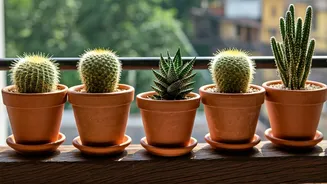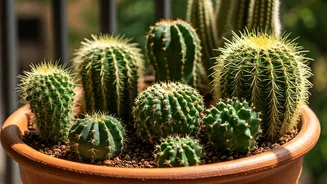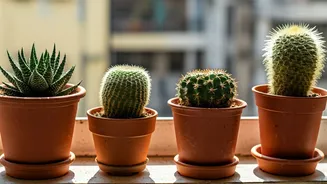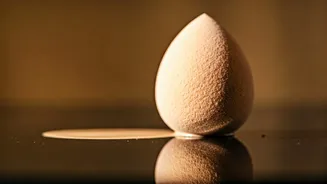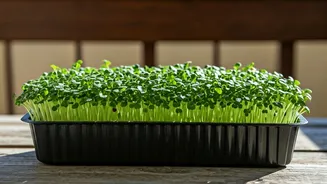Introduction to Cacti
Cacti, known for their ability to thrive in harsh environments, are ideal for Indian balconies due to their low-maintenance nature. They require minimal
watering and can withstand intense sunlight. These characteristics make them perfect for busy individuals seeking a touch of greenery without a significant time commitment. Several types, with their diverse shapes, sizes, and flowering patterns, offer visual interest to any space. Growing cacti is an excellent way to introduce a unique, eye-catching element to your home while also enjoying the therapeutic benefits of gardening.
The Opuntia Family
The Opuntia family, also known as prickly pears, is a great option for Indian balconies because of how easily they can be grown. They are easily recognizable by their flat, pad-like stems. These plants thrive in full sun and well-draining soil, making them perfect for balconies that receive ample sunlight. They can be found in various sizes and shapes, providing versatility when arranging your balcony garden. Ensure the soil is allowed to dry out between waterings to prevent root rot. This family also produces vibrant flowers, adding a pop of color to your space. The Opuntia family is known for its hardiness and ability to tolerate neglect, so it's a great choice for beginner gardeners.
The Mammillaria Genus
The Mammillaria genus contains a vast array of small, rounded cacti, which is excellent for smaller spaces like balconies. They feature prominent tubercles (nipple-like structures) from which spines and flowers emerge. These cacti typically produce a ring of colorful flowers, adding a delightful visual effect. Mammillaria cacti require bright light but can tolerate partial shade, making them adaptable to different balcony conditions. They are also relatively low-maintenance, needing infrequent watering. Proper drainage is essential to ensure they remain healthy. The Mammillaria genus offers a variety of shapes and sizes, allowing you to create a visually appealing display with different types.
The Cereus Cactus
The Cereus cactus, which includes the iconic 'Old Man of the Andes,' is a classic choice for adding height and structure to a balcony garden. These columnar cacti can grow quite tall, making them ideal for creating a focal point. Cereus cacti need full sun exposure and well-draining soil. They are relatively drought-tolerant and require infrequent watering. Some varieties can produce large, fragrant flowers at night, adding an extra layer of interest to your balcony. However, ensure they have sufficient space, as they can grow considerably. These cacti are great for introducing a vertical element and creating a lush atmosphere.
Echinopsis Varieties
Echinopsis cacti, known for their stunning, trumpet-shaped flowers, are another excellent choice for balconies. These cacti come in various shapes and sizes and often produce a profusion of colorful blooms. They require ample sunlight and well-draining soil. Their flowers typically bloom at night or in the early morning, offering a spectacular visual display. Echinopsis cacti are relatively easy to care for and can tolerate periods of drought. Providing proper drainage is essential for healthy growth. These cacti are an excellent choice for adding a touch of elegance and beauty to your balcony garden with their bright flowers.
The Haworthia Genus
The Haworthia genus is perfect for smaller balconies because these are petite plants. These succulents are renowned for their slow growth, unique patterns, and striking textures. They thrive in bright, indirect light and well-draining soil. Haworthias require infrequent watering, making them very low-maintenance. They are suitable for Indian climates and are available in several shapes. They are great for creating a miniature garden with their compact sizes. This genus is known for its durability, and also for its ability to adapt to limited spaces. The Haworthia genus offers a range of aesthetic options, perfect for people who like to collect unusual plants.
Watering and Care
Proper watering is crucial for successfully growing cacti on your balcony. Overwatering is one of the most common issues that leads to root rot. Allow the soil to dry out completely between waterings, especially during the rainy season. Use a well-draining potting mix. In general, water cacti deeply but infrequently. During the growing season, from spring to fall, you might need to water them more frequently. Fertilize them sparingly during the growing season with a cactus-specific fertilizer, diluted to half the recommended strength. Ensure your balcony receives adequate sunlight and ventilation to keep the plants healthy.
